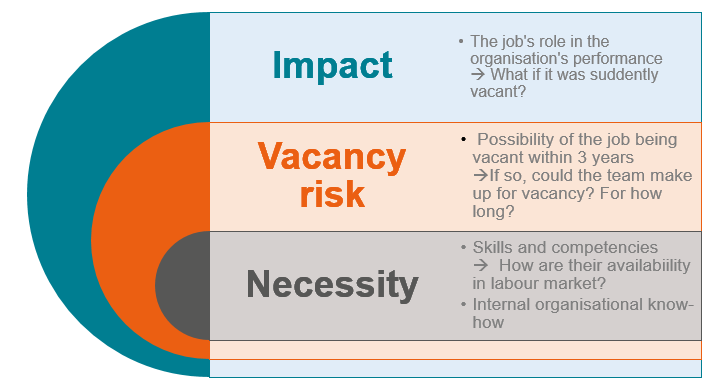Succession planning is a process of preparation, not pre-selection. Organisation regardless of sizes can benefit from implementing a succession plan as it requires the managers, leaders, and HR professionals to conduct a comprehensive and ongoing evaluation on the competencies of every employee as well as taking in the organisational structure and organisation's goals.
In order to ensure the effectiveness of your succession plan, here are the 3-How’s in developing one.
Read more: Succession planning – The influence you can’t ignore

3 Critical Steps in a Succession Planning Process
1. How to identify critical positions?
The very first step of any succession plan is to identify positions that are critical. Certainly, these positions do not limit to just the C-level executives but also roles that can potentially make a significant impact on the organisation operationally and strategically.
Often times, middle management positions do not get the attention they deserve. Organisations tend to forget that these managers also play an important role in the development of a business as they act as a link to connect the C-level and the lower-level employees.
There are three criteria to look for when determining whether or not a position is important to the future of your business.

Let’s take a look at the following examples to have a clearer understanding of how important a position can be.
A "one-man band": Due to the unique circumstances, your employee A is required to "wear many hats" and is the only member/leader in his team. He possesses specialised knowledge and experience that can only be acquired over time. This had made his position truly unique and irreplaceable in the organisation.
Extensive network: Your employee B possesses a rich internal and external network, and if left vacant, can take a toll on the business. She works in a one-of-a-kind location (possibly remote, away from the headquarter), which would be extremely difficult for someone from a different location to cover her task if she’s absent.
Read more: Recipe for successful middle management
2. How to identify and assess potential successors?
Identifying
Once the critical positions have been highlighted, it is time for you to identify the individuals that can potentially fit into those roles when opportunities emerge.
But what should you look for in an individual to say with confidence that they are your "future successor"? A simple and popular method is to examine their Knowledge-Skills-Abilities (KSAs), a.k.a., their competency.
KSAs/ competency is a common terminology used when assessing the current workforce. The results from the assessment are useful in paving an organisation’s development programs, and eventually, your successors’ growth.
Read more: Safeguarding your organisation’s future with competency-based succession planning
Your successor does not mean someone who would think, talk, and react the same way as you. As the environment and the global market changes, you need someone who is ready to take on the position, respect their team members, and ultimately, is competent to lead the team and the company into the future.
Thus, it is essential for you and your organisation when looking for potential candidates for the succession plan to develop a competency profile, which essentially is a set of core competencies applied to a specific role.
You can start building a competency profile by asking these 3 simple questions:
- Where does the company want to be in the next 3 to 5 years?
- What qualities do the new successor of each position ought to have in order to thrive in the role and to meet the company's business objectives?
- How can we ensure that we will have such individuals at our disposal?
Read more: In a world of volatility, invest in employee engagement
Assessing
In our previous articles, we have mentioned that two key factors used to assess potential candidates are the “Potential” and the “Performance.”
An employee's performance is typically evaluated by performance appraisals, whether he/she has achieved the expected set targets within the given timeline and resources. Having said that, managers and leaders can face difficulties when assessing one's performance due to the lack of data or the absence of effective indicators.
On the other hand, the potential factor if not clearly defined can leave both you and your employees in disarray. How potential is "potential" and how can you measure it?
Fortunately, there are a handful of effective assessment tools that you can deploy to evaluate the potential and performance of your future successors:
- 9-box grid
- 360-degree feedback
- OKRs or KPIs
- Psychometric assessments (namely Job-Fit)
- Talent review meetings
- Behaviour-based interviews
- Written examinations
- Simulation exercises or role-playing
- Aptitude tests
- And many more.
3. How to manage successors in a succession plan?
Research has proven that experience-based training is more effective than traditional classroom training in preparing potential candidates for their future roles. It is important to incorporate your training and development strategies with the process of knowledge transfer into your succession planning program to constantly get updated on their experience gains, new competencies, behaviours as well as other "never-before-seen" weaknesses.
Read more: Blurring your employee’s skill gaps and unlock their potential
Training and development
Training and development for both your normal employees and the potential candidates can take many forms, which can be combining both real-life scenarios and in-class training. Below are a few common "exercises" to help ease the candidates into their future roles.
- Stretch assignments: just like the name implies, the employees will have to complete a set of tasks or assignments that "stretch" their limits. Examples include leading a special project, being assigned to a challenging task, or chairing a committee.
- Job rotations: enable the candidates to develop laterally, obtain new experience at a different function that has a different discipline.
- Mentoring and coaching: being taken under the wing of a senior leader provides the candidates with memorable opportunities and reach new heights with ongoing guidance and support.
- Formal training: which can be in the form of classroom training, online courses, or pursuing higher education.
Read more: Employee training and development – Did you do it right?
Knowledge transfer
Knowledge transfer refers to the process of sharing tangible and intellectual property, expertise, skills and learning through a broad range of activities to support mutually beneficial collaborations, from one person to another, from one part of the organisation to another.
When conducting knowledge sharing/ transfer sessions, there are two types of knowledge being shared: explicit knowledge (which are trackable, codified in written forms, such as user guides, manuals, directories, etc.) and tacit knowledge (people's insights, know-hows, judgements, etc.).
The tacit knowledge takes up 80 to 85 per cent of the overall organisation's knowledge asset.
For the transfer of explicit knowledge, it is obvious that organisation will have in their hand a well-documented version of the knowledge in the form of a job diary, best practices, answers to frequently asked questions.
For tacit knowledge, it is more complicated and requires strategies that rely on interpersonal interactions, such as coaching and mentoring. If the transfer of tacit knowledge from one generation to the next is seriously considered, it could lead to a decrease in learning curves for critical positions.
You need not re-invent the wheel when it comes to employee training and knowledge transfer. Your potential candidates should be able to roll with the already established flow that their predecessors have laid down rather than paving the same ground that's already been covered.
Read more: Keep your superheroes – 6 steps to reduce employee turnover
Further note: Leverage technology in succession planning
The process of succession planning generates a substantial amount of data. These are vital information and it needs to be properly collected, organised, stored and analysed. This raises considerable challenges as the task can be very labour intensive and time-consuming.
Advanced technology has brought us various comprehensive HR management software to help us capture key information, which is beneficial for the next generations to use.
Cutting-edge HR solutions today can help track and train leaders by suggesting a leadership plan for every employee. When an employee advances, the senior managers can monitor their progression map and assign newer, more fitting roles.
Read more: What is HR analytics and why do you need to be aware of it?
Many HR solutions nowadays offer a function to compile succession planning data and the capability to generate sensible succession planning program based on organisational structure.
For larger organisations, having a human resource management system with built-in analytics can help to centralise all data in one single repository and extract quality insights to make more informed decisions.
For smaller businesses, the technology can offer an end-to-end approach to talent management, training and succession planning process.
 English
English  Vietnamese
Vietnamese 

